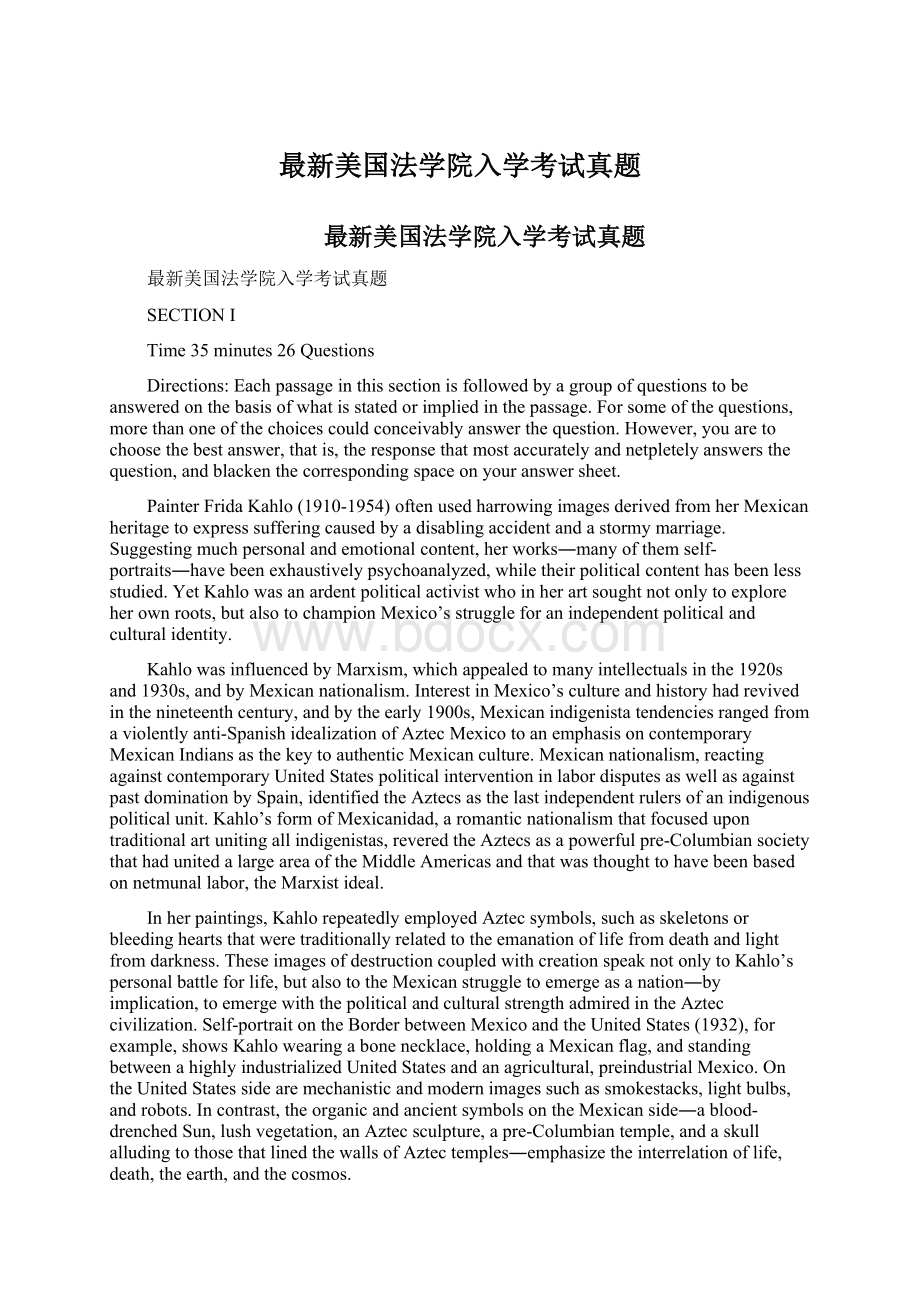最新美国法学院入学考试真题.docx
《最新美国法学院入学考试真题.docx》由会员分享,可在线阅读,更多相关《最新美国法学院入学考试真题.docx(11页珍藏版)》请在冰豆网上搜索。

最新美国法学院入学考试真题
最新美国法学院入学考试真题
最新美国法学院入学考试真题
SECTIONI
Time35minutes26Questions
Directions:
Eachpassageinthissectionisfollowedbyagroupofquestionstobeansweredonthebasisofwhatisstatedorimpliedinthepassage.Forsomeofthequestions,morethanoneofthechoicescouldconceivablyanswerthequestion.However,youaretochoosethebestanswer,thatis,theresponsethatmostaccuratelyandnetpletelyanswersthequestion,andblackenthecorrespondingspaceonyouranswersheet.
PainterFridaKahlo(1910-1954)oftenusedharrowingimagesderivedfromherMexicanheritagetoexpresssufferingcausedbyadisablingaccidentandastormymarriage.Suggestingmuchpersonalandemotionalcontent,herworks―manyofthemself-portraits―havebeenexhaustivelypsychoanalyzed,whiletheirpoliticalcontenthasbeenlessstudied.YetKahlowasanardentpoliticalactivistwhoinherartsoughtnotonlytoexploreherownroots,butalsotochampionMexico’sstruggleforanindependentpoliticalandculturalidentity.
KahlowasinfluencedbyMarxism,whichappealedtomanyintellectualsinthe1920sand1930s,andbyMexicannationalism.InterestinMexico’scultureandhistoryhadrevivedinthenineteenthcentury,andbytheearly1900s,Mexicanindigenistatendenciesrangedfromaviolentlyanti-SpanishidealizationofAztecMexicotoanemphasisoncontemporaryMexicanIndiansasthekeytoauthenticMexicanculture.Mexicannationalism,reactingagainstcontemporaryUnitedStatespoliticalinterventioninlabordisputesaswellasagainstpastdominationbySpain,identifiedtheAztecsasthelastindependentrulersofanindigenouspoliticalunit.Kahlo’sformofMexicanidad,aromanticnationalismthatfocusedupontraditionalartunitingallindigenistas,reveredtheAztecsasapowerfulpre-ColumbiansocietythathadunitedalargeareaoftheMiddleAmericasandthatwasthoughttohavebeenbasedonnetmunallabor,theMarxistideal.
Inherpaintings,KahlorepeatedlyemployedAztecsymbols,suchasskeletonsorbleedingheartsthatweretraditionallyrelatedtotheemanationoflifefromdeathandlightfromdarkness.TheseimagesofdestructioncoupledwithcreationspeaknotonlytoKahlo’spersonalbattleforlife,butalsototheMexicanstruggletoemergeasanation―byimplication,toemergewiththepoliticalandculturalstrengthadmiredintheAzteccivilization.Self-portraitontheBorderbetweenMexicoandtheUnitedStates(1932),forexample,showsKahlowearingabonenecklace,holdingaMexicanflag,andstandingbetweenahighlyindustrializedUnitedStatesandanagricultural,preindustrialMexico.OntheUnitedStatessidearemechanisticandmodernimagessuchassmokestacks,lightbulbs,androbots.Incontrast,theorganicandancientsymbolsontheMexicanside―ablood-drenchedSun,lushvegetation,anAztecsculpture,apre-Columbiantemple,andaskullalludingtothosethatlinedthewallsofAztectemples―emphasizetheinterrelationoflife,death,theearth,andthecosmos.
KahloportrayedAztecimagesinthefolkloricstyleoftraditionalMexicanpaintings,therebyheighteningtheclashbetweenmodernmaterialismandindigenoustradition;similarly,shefavoredplannedeconomicdevelopment,butnotattheexpenseofculturalidentity.Heruseoffamiliarsymbolsinareadilyaccessiblestylealsoservedhergoalofbeingpopularlyunderstood;inturn,KahloisviewedbysomeMexicansasamythicfigurerepresentativeofnationalismitself.
1.Whichoneofthefollowingbestexpressesthemainpointofthepassage?
(A)ThedoctrinesofMarxistideologyandMexicannationalismheavilyinfluencedMexicanpaintersofKahlo’sgeneration.
(B)Kahlo’spaintingscontainnumerousreferencestotheAztecsasanindigenousMexicanpeoplepredatingEuropeaninfluence.
(C)AnimportantelementofKahlo’sworkisconveyedbysymbolsthatreflectheradvocacyofindigenousMexicancultureandMexicanpoliticalautonomy.
(D)TheuseofAztecimagesandsymbolsinKahlo’sartcanbetracedtothelatenineteenth-centuryrevivalofinterestinMexicanhistoryandculture.
(E)KahlousedAztecimageryinherpaintingsprimarilyinordertofostercontemporaryappreciationfortheauthenticartoftraditionalMexicanculture.
2.WithwhichoneofthefollowingstatementsconcerningpsychoanalyticandpoliticalinterpretationsofKahlo’sworkwouldtheauthorbemostlikelytoagree?
(A)ThepsychoanalyticinterpretationsofKahlo’sworktendtochallengethepoliticalinterpretations.
(B)PoliticalandpsychoanalyticinterpretationsarenetplementaryapproachestoKahlo’swork.
(C)RecentpoliticalinterpretationsofKahlo’sworkarecausingpsychoanalyticcriticstorevisetheirowninterpretations.
(D)Unlikethepoliticalinterpretations,thepsychoanalyticinterpretationsmakeuseofbiographicalfactsofKahlo’slife.
(E)Kahlo’smythicstatusamongtheaudienceKahlomostwantedtoreachisbaseduponthepsychoanalyticratherthanthepoliticalcontentofherwork.
3.WhichoneofthefollowingstancestowardtheUnitedStatesdoesthepassagementionascharacterizingMexicannationalistsintheearlytwentiethcentury?
(A)oppositiontoUnitedStatesinvolvementininternalMexicanaffairs
(B)desiretodecreaseemigrationoftheMexicanlaborforcetotheUnitedStates
(C)desiretoimproveMexico’seconomicnetpetitivenesswiththeUnitedStates
(D)reluctancetoimitatetheUnitedStatesmodelofrapidindustrialization
(E)advocacyofagovernmentbaseduponthatoftheMarxistSovietUnionratherthanthatoftheUnitedStates
4.Inthecontextofthepassage,whichoneofthefollowingphrasescouldbestbesubstitutedfortheword“romantic”(line24)withoutsubstantiallychangingtheauthor’smeaning?
(A)dreamyandescapist
(B)nostalgicandidealistic
(C)fancifulandimaginative
(D)transcendentalandimpractical
(E)overwroughtandsentimental
5.ThepassagementionseachofthefollowingasanAztecsymbolorimagefoundinKahlo’spaintingsEXCEPTa
(A)skeleton
(B)sculpture
(C)serpent
(D)skull
(E)bleedingheart
6.Whichoneofthefollowingbestdescribestheorganizationofthethirdparagraph?
(A)contrastofopposingideas
(B)reconciliationofconflictingconcepts
(C)interrelationofnetplementarythemes
(D)explicationofaprinciple’simplications
(E)supportforageneralizationbymeansofanexample
7.ThepassageimpliesthatKahlo’sattitudetowardtheeconomicdevelopmentofMexicowas
(A)enthusiastic
(B)condemnatory
(C)cautious
(D)nonnetmittal
(E)uncertain
8.Themainpurposeofthepassageisto
(A)critiqueanartist’sstyle
(B)evaluateopposingtheories
(C)reconcileconflictingarguments
(D)advocateanadditionalinterpretation
(E)reconsideranartistinlightofnewdiscoveries
参考答案:
1-8CBABCECD
Inrecentyears,agrowingbeliefthatthewaysocietydecideswhattotreatastrueiscontrolledthroughlargelyunrecognizeddiscursivepracticeshasledlegalreformerstoexaminethenetplexinterconnectionsbetweennarrativeandlaw.Inmanylegalsystems,legaljudgmentsarebasedonnetpetingstoriesaboutevents.Withouthavingwitnessedtheseevents,judgesandjuriesmustvalidatesomestoriesastrueandrejectothersasfalse.Thisprocedureisrootedinobjectivism,aphilosophicalapproachthathassupportedmostWesternlegalandintellectualsystemsforcenturies.Objectivismholdsthatthereisasingleneutraldescriptionofeacheventthatisunskewedbyanyparticularpointofviewandthathasaprivilegedpositionoverallotheraccounts.Thelaw’squestfortruth,therefore,consistsoflocatingthisobjectivedescription,theonethattellswhatreallyhappened,asopposedtowhatthoseinvolvedthoughthappened.Theseriousflawinobjectivismisthatthereisnosuchthingastheneutral,objectiveobserver.Aspsychologistshavedemonstrated,allobserversbringtoasituationasetofexpectations,values,andbeliefsthatdeterminewhattheobserversareabletoseeandhear.Twoindividualslisteningtothesamestorywillheardifferentthings,becausetheyemphasizethoseaspectsthataccordwiththeirlearnedexperiencesandignorethoseaspectsthataredissonantwiththeirviewoftheworld.Hencethereisneveranyescapeinlifeorinlawfromselectiveperceptionorfromsubjectivejudgmentsbasedonpriorexperiences,values,andbeliefs.
Thesocietalharmcausedbytheassumptionofobjectivistprinciplesintraditionallegaldiscourseisthat,historically,thestoriesjudgedtobeobjectivelytruearethosetoldbypeoplewhoaretrainedinlegaldiscourse,whilethestoriesofthosewhoarenotfluentinthelanguageofthelawarerejectedasfalse.
LegalscholarssuchasPatriciaWilliams,DerrickBell,andMariMatsudahavesoughtempowermentforthelattergroupofpeoplethroughtheconstructionofalternativelegalnarratives.Objectivistlegaldiscoursesystematicallydisallowsthelanguageofemotionandexperiencebyfocusingoncognitioninitsnarrowestsense.Theselegalreformersproposereplacingsuchabstractdiscoursewithpowerfulpersonalstories.Theyarguethattheabsorbing,nonthreateningstructureandtoneofpersonalstoriesmayconvincelegalinsidersforthefirsttimetolistentothosenotfluentinlegallanguage.Thenetpellingforceofpersonalnarrativecancreateasenseofempathybetweenlegalinsidersandpeopletraditionallyexcludedfromlegaldiscourseand,hence,frompower.Suchalternativenarrativescanshatterthenetplacencyofthelegalestablishmentanddisturbitstranquility.Thus,theengagingpowerofnarrativemightplayacrucial,positiveroleintheprocessoflegalreconstructionbyovernetingdifferencesinbackgroundandtrainingandforminganewcollectivitybasedone